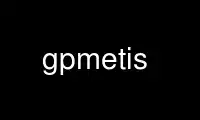
This is the command gpmetis that can be run in the OnWorks free hosting provider using one of our multiple free online workstations such as Ubuntu Online, Fedora Online, Windows online emulator or MAC OS online emulator
PROGRAM:
NAME
gpmetis - manual page for gpmetis 5.1.0
SYNOPSIS
gpmetis [options] graphfile nparts
DESCRIPTION
Required parameters
graphfile
Stores the graph to be partitioned.
nparts The number of partitions to split the graph.
Optional parameters
-ptype=string
Specifies the scheme to be used for computing the k-way partitioning. The possible
values are:
rb - Recursive bisectioning
kway - Direct k-way partitioning [default]
-ctype=string
Specifies the scheme to be used to match the vertices of the graph during the
coarsening. The possible values are:
rm - Random matching
shem - Sorted heavy-edge matching [default]
-iptype=string [applies only when -ptype=rb]
Specifies the scheme to be used to compute the initial partitioning of the graph.
The possible values are:
grow - Grow a bisection using a greedy scheme [default for ncon=1]
random - Compute a bisection at random [default for ncon>1]
-objtype=string [applies only when -ptype=kway]
Specifies the objective that the partitioning routines will optimize. The possible
values are:
cut - Minimize the edgecut [default]
vol - Minimize the total communication volume
-no2hop
Specifies that the coarsening will not perform any 2-hop matchings when the
standard matching fails to sufficiently contract the graph.
-contig [applies only when -ptype=kway]
Specifies that the partitioning routines should try to produce partitions that are
contiguous. Note that if the input graph is not connected this option is ignored.
-minconn [applies only when -ptype=kway]
Specifies that the partitioning routines should try to minimize the maximum degree
of the subdomain graph, i.e., the graph in which each partition is a node, and
edges connect subdomains with a shared interface.
-tpwgts=filename
Specifies the name of the file that stores the target weights for each partition.
By default, all partitions are assumed to be of the same size.
-ufactor=int
Specifies the maximum allowed load imbalance among the partitions. A value of x
indicates that the allowed load imbalance is 1+x/1000. For ptype=rb, the load
imbalance is measured as the ratio of the 2*max(left,right)/(left+right), where
left and right are the sizes of the respective partitions at each bisection. For
ptype=kway, the load imbalance is measured as the ratio of max_i(pwgts[i])/avgpwgt,
where pwgts[i] is the weight of the ith partition and avgpwgt is the sum of the
total vertex weights divided by the number of partitions requested. For ptype=rb,
the default value is 1 (i.e., load imbalance of 1.001). For ptype=kway, the
default value is 30 (i.e., load imbalance of 1.03).
-ubvec=string
Applies only for multi-constraint partitioning and specifies the per constraint
allowed load imbalance among partitions. The required parameter corresponds to a
space separated set of floating point numbers, one for each of the constraints. For
example, for three constraints, the string can be "1.02 1.2 1.35" indicating a
desired maximum load imbalance of 2%, 20%, and 35%, respectively. The load
imbalance is defined in a way similar to ufactor. If supplied, this parameter
takes priority over ufactor.
-niter=int
Specifies the number of iterations for the refinement algorithms at each stage of
the uncoarsening process. Default is 10.
-ncuts=int
Specifies the number of different partitionings that it will compute. The final
partitioning is the one that achieves the best edgecut or communication volume.
Default is 1.
-nooutput
Specifies that no partitioning file should be generated.
-seed=int
Selects the seed of the random number generator.
-dbglvl=int
Selects the dbglvl.
-help
Prints this message.
Use gpmetis online using onworks.net services
